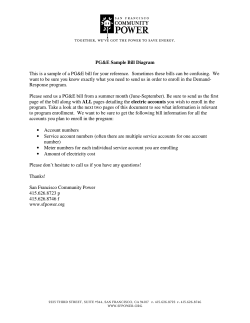
Finance Professionals Seminar Financing the Domestic Energy Markets Simon Schwarz
Finance Professionals Seminar Financing the Domestic Energy Markets – A Changing Risk Landscape Simon Schwarz Financing the Domestic Energy Markets • Introduction • Basics • Typology of Risks • Putting it All Together Introduction • National Electricity Market (NEM) inter-connecting the Eastern Australian States. • World’s longest interconnected AC power system. • Relatively simple and large market, few firms, relatively few assets – easy to model. • We will focus on the wholesale generation market within the NEM. Source: Australian Electricity Market Operator, “Pivotal to Australia’s Energy Future”, August 2012 Basics • Value of a firm or asset is the discounted value of future net cash flows expected to be received by that firm or asset. • Revenue streams are the value of electricity generated and sold (plus LGCs for renewable generation, minus carbon price for fossil fuel generation). • Spot prices are determined by SRMC. • Future price paths are determined by LRMC. Wholesale Price of Electricity • The transport of electricity from generators to consumers is facilitated through a ‘pool’ or spot market, where the output from all generators is aggregated and scheduled at regular intervals through the day to meet demand. • All generators bid capacity into the pool at these intervals. The clearing price of electricity is set at the level where aggregate bid capacity at that price exactly meets demand for that interval. Short Run Marginal Cost • Generation portfolios enter into electricity derivative contracts to hedge wholesale revenues in order to reduce earnings risk. • Thus, generators are considered indifferent to spot price movements across the volume of these contracts except where the spot price falls below its Short Run Marginal Cost (STMC). • Optimal strategy: for a generator is therefore to offer all contracted generation at SRMC. Long Run Marginal Cost • Basic premise: if market prices are significantly and persistently above Long Run Marginal Cost (LRMC) then this should, given time, prompt new generation investment that restores prices to those levels. • Classic definition of the LRMC of generation: the levelised cost of meeting an increase in demand over an extended period of time. • LRMC = Sources: Δ NPV of costs Δ NPV of load NERA Economic Consulting, “Estimating LRMC in the National Electricity Market”, December 2011 Intelligent Energy Systems, “The Long Run Marginal Cost of Electricity in NSW”, February 2004 Long Run Marginal Cost (cont.) • Theoretical generation program utilises existing generation, committed developments, and the most efficient new generation entry. • Relies on accurate forecasts of levelised costs of entry (LCOE) of different generation technologies over time. • LRMC calculation relies on accurate forecasts of future load profile (demand) – both volume and shape. Typology of Risks – Market Risk • Market Risk: the risk that changes in market prices will reduce the value of a firm or asset. • The value of firms or assets operating in the NEM is primarily affected by the long run price path of electricity, which determines the value of their long run revenue streams. • Mitigants – hedging, fixed price power purchase agreements, vertical integration, low gearing. Market Risk Mitigants • Hedging – fine in theory, but in practice: both OTC and exchange traded hedging features basis risk, limited tenors, limited liquidity. Source: ASX Electricity Base Load Quarterly Futures NSW, www.sfe.com.au/content/prices/rtp15sfBN.html , accessed on 15th August 2014 Market Risk Mitigants • PPAs – Fine in theory, but in practice: limited universe of creditworthy counterparties, high bargaining power of suppliers, leading to low prices, short-medium tenors, if available at all. • Also introduces legal risk, eg. on existence and nature of clean energy frameworks such as carbon price, renewable energy certificates. Who takes the repeal risk? Market Risk Mitigants • Vertical Integration – using a retail business to on-sell to consumers under essentially fixedprice retail tariffs, as an internal hedge. • This is the mechanism chosen by the large incumbents, all 3 of whom have become vertically integrated “Gentailers”. • Has been touted by other major generators such as Pacific Hydro. Market Risk Mitigants • Low gearing – occasionally a generation asset can be financed on a merchant basis, ie. without long term hedging or power purchase agreement. • Typically this is done using project finance at low gearing levels so the project maintains robust debt serviceability ratios even under strong downside scenarios in power price, eg. Westpac project finance of Woodlawn windfarm in 2011. • Equity is still exposed to substantial market risk, now leveraged! Typology of Risks – Model Risk • Model Risk: risk that a model used to measure value or risk of investments and financial positions is wrong. May be due to internal error, misapplication, incorrect assumptions or misinterpretation of results. How Many Modelling Firms Does it Take to Change a RET Lightglobe? • Renewable Energy Target modelling 2012-2014 – – – – – – – – – – ACIL Allen for RET Review Panel Frontier Economics for Australian Energy Market Commission ROAM Consulting for Clean Energy Council Sinclair Knight Mertz for Climate Change Authority Jacobs SKM for the Climate Institute, the Australian Conservation Federation and WWF Australia Centre for International Economics for the Australian Industry Greenhouse Network Deloitte for Australian Chamber of Commerce and Industry, Business Council of Australia, Minerals Council of Australia BAEconomics for APPEA Intelligent Energy Systems, public newsletter Schneider Electric, public white paper Generation Capacity Increased even as Demand Declined (NEM 2007-14) Source: AEMO and Energy Australia presentation in RenewEconomy, 8th August 2014 Continual Demand Over-Forecasting Source: AEMO, “February Update: Supply-Demand Snapshot for the NEM”, March 2014 Continual Demand Over-Forecasting Source: AGL Energy presentation 2013 and AEMO in Citi Research, “Energy Darwinism in Australian Utilities”, 10th February 2014 Solar PV Changes Load Profile Source: Energy Networks Association, “The Road to Fairer Prices”, April 2014 LCOE by Technology as at Dec 2013 Source: BREE, Australian Energy Technology Assessment 2013 Model Update Large changes in 2050 LCOE forecasts Source: BREE, Australian Energy Technology Assessment 2013 Model Update Rapid Decline in Price of Solar PV Source: Bloomberg New Energy Finance in Citi Research, “Energy Darwinism in Australian Utilities, 10th February 2014 Typology of Risks – Reputation Risk and Operational Risk • Reputation Risk: potential loss resulting from a decrease in a firm’s standing in public opinion. • Operational Risk: the risk of loss resulting from inadequate or failed processes, people and systems or from external events. • Often these risks go hand-in-hand Loss of Stakeholder Trust Source: Sydney Morning Herald, 11th August 2014 Costs of Reputation Risk Source: Thomas, T., Schermerhorn, J.R., Dienhart, J.W., “Strategic leadership of ethical behaviour in business”, Academy of Managemenr Executive, 2004, in Heslin, P., AGSM, SM2 presentation, 2014 Typology of Risks – Political Risk • Political Risk: risk that an investment's returns could suffer as a result of political changes. Source: The Australian Financial Review, 18th August 2014 Carbon Tax Repeal Source: ASX & Media Release, AGL, 17th July 2014 LGC prices buffeted by political winds Source: Pacific Hydro data, 15th July 2014 Typology of Risks – Strategic Risk • Strategic Risk: potential loss due to a decrease in the competitive position of a firm. • This risk is a function of a firm’s chosen strategy, those of its competitors, and the (changing) nature of the market and value chain in which it operates. Loss in Value of German Utilities Sources: Thomson Reuters in The Economist, 7th June 2014 The Economist, 12th October 2013 Value Chain in Transformation Source: IBM Institute for Business Value in Eurelectric, “Utilities: Powerhouses of Innovation”, 8th May 2013 New Market Models Source: AGL Energy Limited, FY Full Year Results Presentation, 30th June 2014 Changing Business Models Source: CSIRO, Future Grid Forum report: “Change and choice”, December 2013 Putting It All Together • Investing in a stable market • Investing in a disrupted market Risk Investing in a Stable Market Technology R&D Growth Business Utility Company Investment Class Generation Asset Investing in a Disrupted Market Stranded assets Risk Portfolio approach Broken business models Riding the disruption Technology R&D Growth Business Utility Company Investment Class Generation Asset Thank you • Questions?
© Copyright 2025

















